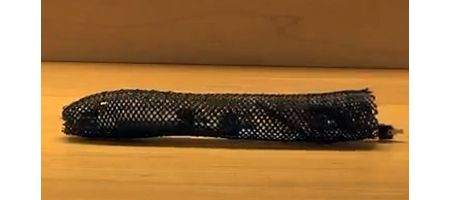MIT’s created a robot that crawls along the ground like an earthworm by contracting and expanding segments of its body.

Developed with support from the Pentagon, the Meshwom moves by peristalsis, alternately squeezing and stretching the ‘muscles’ along its body and inching forward with each wave of contractions.
Made almost entirely of soft materials, it’s remarkably resilient, says MIT, and can survive even when stepped upon or whacked with a hammer.
“You can throw it, and it won’t collapse,” says assistant professor of engineering Sangbae Kim.
“Most mechanical parts are rigid and fragile at small scale, but the parts in Meshworms are all fibrous and flexible. The muscles are soft, and the body is soft … we’re starting to show some body-morphing capability.”
The robot’s artificial muscles are based on wire made of nickel and titanium — a shape-memory alloy that stretches and contracts with heat. The wire’s wound around a tube, creating segments along its length, much like those of an earthworm.
A small current is applied to the segments of wire, squeezing the mesh tube and propelling the robot forward.
There’s a good reason for working on soft robots. Without breakable hardware, they’d be better at exploring hard-to-reach spaces and crossing bumpy terrain.
But a big problem has been designing soft actuators, or motors, to power such robots. One solution has been to use compressed air – but this means bulky pumps. The peristaltic approach avoids this problem.
“Even though the robot’s body is much simpler than a real worm — it has only a few segments — it appears to have quite impressive performance,” says Kellar Autumn, a professor of biology at Lewis and Clark College.
“I predict that in the next decade we will see shape-changing artificial muscles in many products, such as mobile phones, portable computers and automobiles.”






